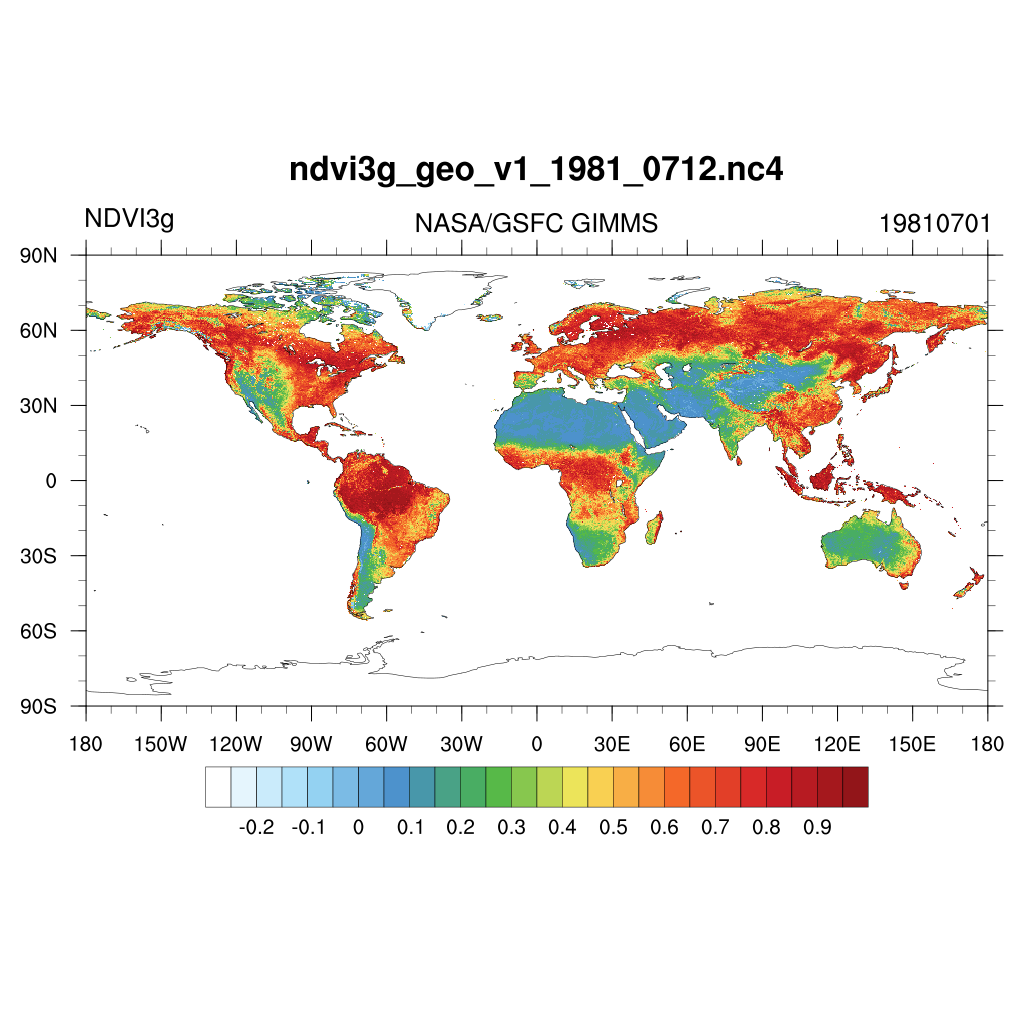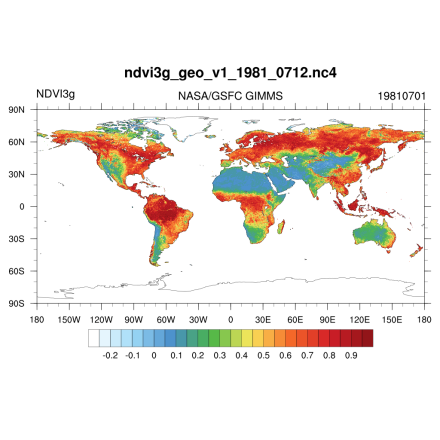NDVI: Normalized Difference Vegetation Index-3rd generation: NASA/GFSC GIMMS

Normalized Difference Vegetation Index-3rd generation (NDVI) using the Global Inventory Monitoring and Modeling System (GIMMS): Vegetation indices are radiometric measures of photosynthetically active radiation absorbed by chlorophyll in the green leaves of vegetation canopies and are therefore good surrogate measures of the physiologically functioning surface greenness level of a region. For 30 years, Compton J. Tucker created the NDVI time series within the framework of the Global Inventory Monitoring and Modeling System (GIMMS) project. He carefully assemblied it from different AVHRR sensors and accounting for various deleterious effects, such as calibration loss, orbital drift, volcanic eruptions, etc. The latest version of the GIMMS NDVI data set spans the period July 1981 to December 2015 and is termed NDVI3g (third generation GIMMS NDVI from AVHRR sensors).
The USGS Remote sensing phenology states: "NDVI values range from +1.0 to -1.0. Areas of barren rock, sand, or snow usually show very low NDVI values (for example, 0.1 or less). Sparse vegetation such as shrubs and grasslands or senescing crops may result in moderate NDVI values (approximately 0.2 to 0.5). High NDVI values (approximately 0.6 to 0.9) correspond to dense vegetation such as that found in temperate and tropical forests or crops at their peak growth stage."
Key Strengths
Very high resolution (1/12 degree).
While not a CDR, this data set has undergone careful evolution.
Each data file contains a convenient half-month composite.
Key Limitations
The netCDF-4 file does not adhere to any file convention (eg: CF)
Cite this page
Acknowledgement of any material taken from or knowledge gained from this page is appreciated:
National Center for Atmospheric Research Staff (Eds). Last modified "The Climate Data Guide: NDVI: Normalized Difference Vegetation Index-3rd generation: NASA/GFSC GIMMS.” Retrieved from https://climatedataguide.ucar.edu/climate-data/ndvi-normalized-difference-vegetation-index-3rd-generation-nasagfsc-gimms on 2026-01-07.
Citation of datasets is separate and should be done according to the data providers' instructions. If known to us, data citation instructions are given in the Data Access section, above.
Acknowledgement of the Climate Data Guide project is also appreciated:
Schneider, D. P., C. Deser, J. Fasullo, and K. E. Trenberth, 2013: Climate Data Guide Spurs Discovery and Understanding. Eos Trans. AGU, 94, 121–122, https://doi.org/10.1002/2013eo130001
Other Information
- Pinzon, J.E.; Tucker, C.J. (2014): A Non-Stationary 1981-2012 AVHRR NDVI3g Time Series; Remote Sens. 2014, 6, 6929-6960.
- Tucker, C.J.; Pinzon, J.E.; Brown, M.E.; Slayback, D.A.; Pak, E.W.; Mahoney, R.; Vermote, E.F.; Saleous, N. An extended AVHRR-8km NDVI dataset compatible with MODIS and SPOT vegetation NDVI data. Int. J. Remote Sens. 2005, 26, 4485–4498.
